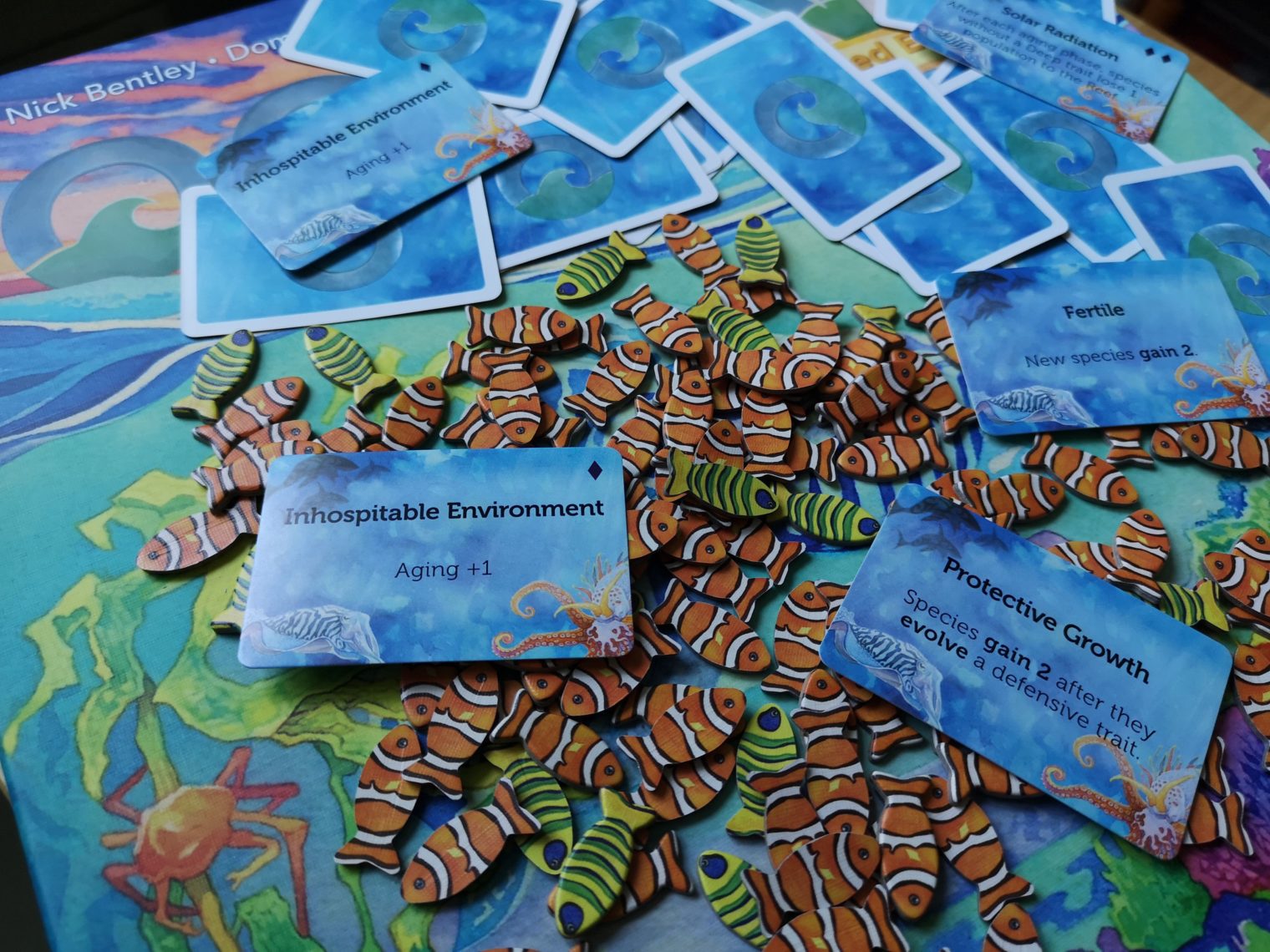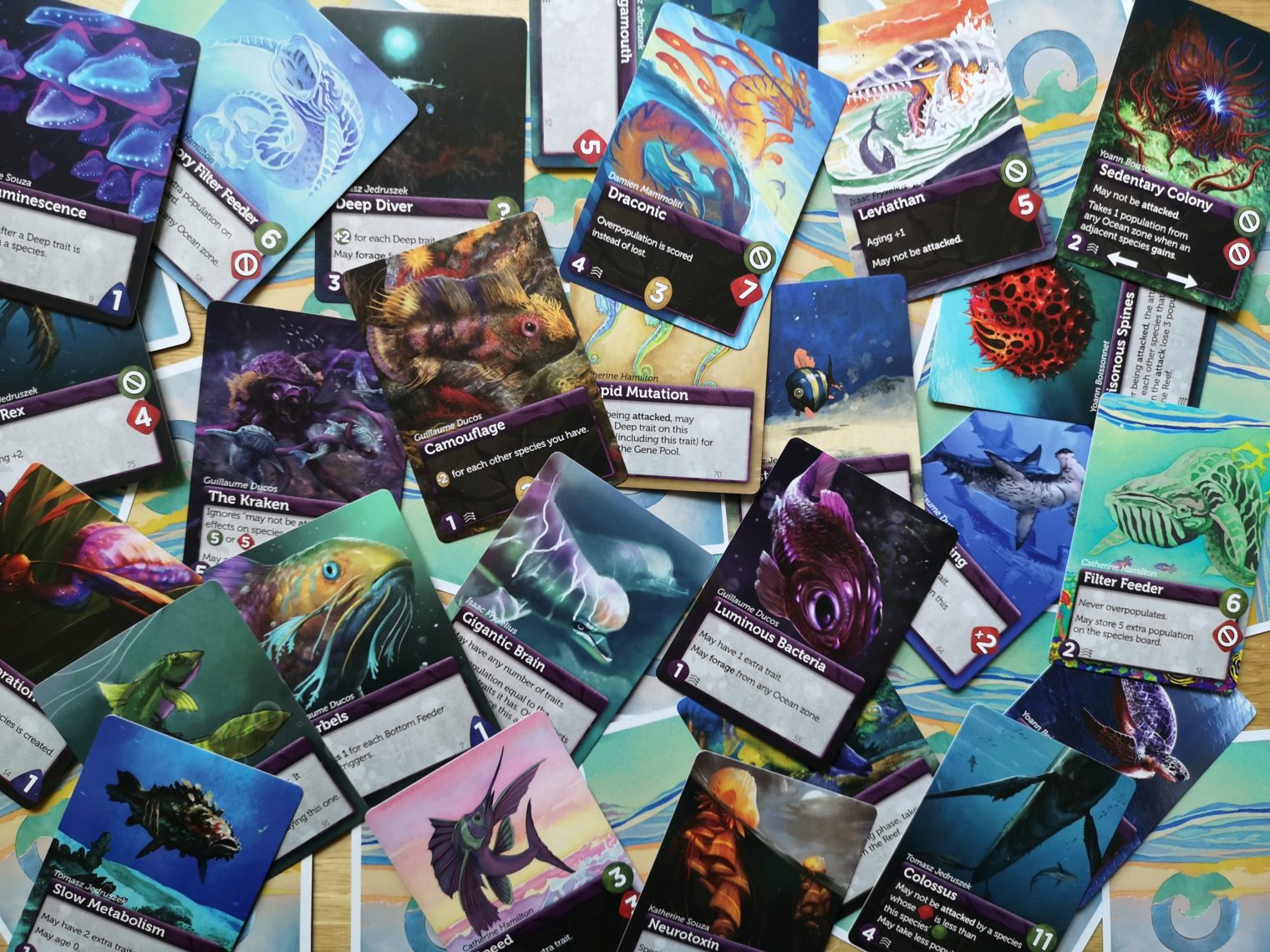When I was a kid, my family had a janky PC running Windows 3.1, and I would always be on there playing all sorts of games – among them was SimLife. Now, you’re likely aware of SimCity but maybe not some of the variations like SimLife. What my nature- / science-loving young brain adored about SimLife was the strange combinations of traits that I could combine to make weird new animals. When I first tried North Star’s Evolution, I got a very “SimLife” vibe from it – and their new iteration on the game, Oceans, is no different.
Players will spend their pre- and post-Cambrian ages in Oceans Frankenstein-ing creatures of the seas and feeding their populations – be that by a peaceful forage or a somewhat more aggressive attack. This part is quite similar to the feeding in Evolution, but the source of food will be a bit of a timer for the game – once the first ocean zone is empty of population, the Cambrian explosion occurs, allowing players to access the “Deep” cards with unique evolutionary traits and play 2 cards (rather than 1) card per turn. Once every zone in the ocean is empty of population, the game ends. It’s also a progression that is visually accessible at a glance, which makes it easier to track.
Gameplay overall is fairly simple – on a player’s turn, they will play a card (either migrating population from the ocean to the reef for feeding, or to play a trait on a new/existing species), choose one species to feed (either from the reef or by attacking another species), age the population of each of their species (removing a population to your end-game scoring pile) and then draw up to their hand limit.

Handling your species tableau before the Cambrian phase is fairly straightforward, as there is a finite set of traits – for example, “Symbiotic” which allows your species to gain population after a neighbouring species feeds, and the “Apex Predator” which attacks other species rather than feeding from the reef. Once the Deep cards and their unique traits come into play, things get more complicated – it can be tricky knowing what to play when you’re faced with decisions like “Electrreception” that lets a species ignore a defensive trait of the species they’re attacking, or perhaps the “Giant Cephalopod” that allows a species to feed a massive additional three times. Overall, keeping track of more than a couple of species in play – especially once there are multiple leeching or attack traits – might be a bit much. Plenty of fish in the sea to juggle, I suppose – and once you get a decent engine going for maintaining population growth for a few, it’s guaranteed points for game-end to keep an eye on those ones and perhaps let others slip. I am hesitant to let go of things I spend turns on in games a lot of the time, so that’s a big flaw of mine for playing Oceans.

I would be remiss, of course, not to mention the art of this game. The incredible watercolour style used for much of the game’s components and trait cards makes a beautiful splash on the table. Some of the deep cards, by contrast, have a very natural history-like illustration style with dramatic colours (from other contributing artists than the two credited, notably). I must admit, that even with the gorgeous cards and reef/ocean trays I did prefer playing another friend’s copy with the plastic fish (Kickstarter edition) which were quite striking and a little easier to handle than the cardboard fish chits in my version of the game (even with their flashy patterns). It’s really lovely to see a game about nature have some more diverse art styles, and I appreciate the look that Oceans has.
While I’m not sure if it’s necessary to have both Evolution and Oceans, I do enjoy what Oceans brings to the table as far as its differences in gameplay. The game can run a little long at the full complement of players as folks juggle the aforementioned tableaus, but doesn’t outstay its welcome (unless you have someone who is prone to analysis paralysis!). The concepts are simple enough overall that this could be a great gateway into more complex tableau- / engine-building games for newer players, too. You’re sure to have a whale of a time. (Hey, I waited this whole review to use a pun, give me a break.)
Oceans is a tableau-building card game for 2-4 players, taking approximately 60-90 minutes. Designed by Nick Bentley, Dominic Crapuchettes, Ben Goldman & Brian O’Neill with art by Guillaume Ducos & Catherine Hamilton, it is published by North Star Games. Thank you to North Star for providing a review copy of the game.
Comments
No comments yet! Be the first!